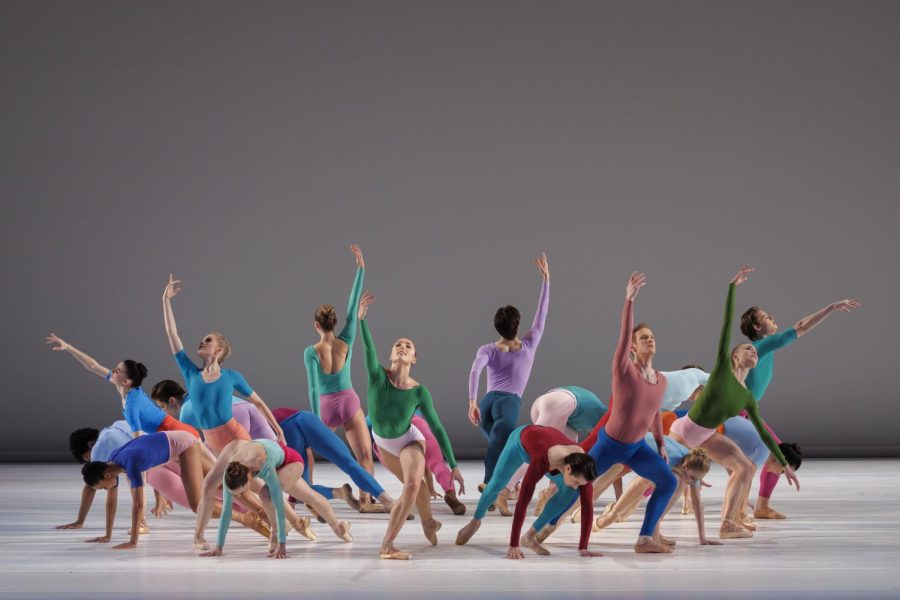‘Copland Dance Episodes’: A Nod to the Golden Age of American Film
Justin Peck gives us a taste of the midcentury in his first evening-length work with NYCB
More stories from BRETT DALIS
Justin Peck, resident choreographer and former soloist of the New York City Ballet (NYCB), debuted his 23rd work for the ballet company on Jan. 26. In his first full evening work — or performance that is long enough to be presented for an evening performance — “Copland Dance Episodes,” he reintroduced the beauty of composer Aaron Copland’s compositions with NYCB’s trademark minimalist staging.
Even before the lights dimmed, the audience was met with a preview of what was to come with an array of vibrant colors and geometric shapes on the stage’s curtain, designed by artist and sculptor Jeffrey Gibson.
Gibson drew from both his Choctaw Cherokee heritage and his experiences with urban culture across the country as inspirations for his artwork, utilized here to create a display of neon as a “Welcome” to the audience.
Peck is no stranger to dividing his ballets into episodelike movements. In fact, “Copland Dance Episodes” is an expansion of his 2015 work, “Rodeo: Four Episodes,” a reimagined take on the classic score created by Copland for dancer Agnes de Mille in 1942.
Returning to the lightheartedness of postwar-era media ensured that audiences could associate that same tone with new works today.
Peck’s intention behind dividing the ballet into four distinct parts was to convey different choreographic themes based on various Copland scores. These scores include selections from “Appalachian Spring,” “Billy the Kid: Ballet Suite,” “Fanfare for the Common Man” and Rodeo. Each movement took inspiration from ideas such as the weather, flight and engines. The resulting sections of the ballet presented the audience with a highly energetic and playful work.
Among these works that reflect a similar amount of verve include NYCB staples such as “A Midsummer Night’s Dream” and “Andantino.” These pieces helped establish the individuality of the company as a force in the ballet industry that challenged the romanticism of European ballet companies in the early 20th century. That being said, NYCB is no stranger to performing the classics, with their own versions of “The Sleeping Beauty” and “Swan Lake.” A factor of what makes “Copland Dance Episodes” stand out is the decision to create a ballet that rivals the length of these classics while maintaining the neoclassicism that NYCB is known for.
As the curtain opened on his Jan. 26 show, the stage revealed the company dynamically posed with white tulle draped over their bodies. In true NYCB fashion, both the costumes and set avoided being too extravagant in order to keep the focus on the dance and expression of the piece. The dancers were dressed simply in color-blocked neon leotards and tights — with the women in shorts — and staged on a completely white background.
Peck reminded the crowd of the carefree nature of mid-1900s cinema. He did this through incorporating tropes that are reminiscent of the movies from this era in the choreography, such as musical films “Hello, Dolly!” and “Singing in the Rain.” He made room for moments of humor and created a sense of familiarity between the choreography and media of the time, which allowed the work to become more accessible than a classic story ballet would be to a general audience.
Full-length ballets such as “Swan Lake” are subject to losing their appeal to crowds without a background in ballet or other kinds of concert dance, as they are often long and very story-driven. Even as a ballet dancer myself, I can say that sometimes the classics seem to drag on. Peck did a good job at avoiding this by making the episodes comparable to the movie musicals of the 1900s that are so beloved.
Where this ballet falls short, ironically, has little to do with the choreography or staging. Instead, my biggest grievance with the performance is that it seemed to lack cohesive movement in the ensemble.
NYCB and its affiliated school, the School of American Ballet, train their dancers in a style of ballet developed by George Balanchine. This pedagogical method, aptly named Balanchine, takes from the Russian style of ballet and develops it further in its athleticism, dynamics and energy. Balanchine has become a standard school of training for ballet in America, with major companies such as Pacific Northwest Ballet and Boston Ballet all adopting it.
Difficulties can arise with the Balanchine style when attempting to choreograph works for a corps de ballet, especially for a ballet as exciting as “Copland Dance Episodes.” Because Balanchine is so focused on individuality and Peck’s choreography fully embodied that trait, the piece arguably looked disjointed at times when the ensemble danced synchronously.
Something that piqued my interest about this ballet was the decision to abide by the NYCB tradition of keeping the costuming and staging to a minimum. In the original ballet, the costume design (done by Reid Bartelme, Harriet Jung and Peck himself) aligned closer with what many typically think of clothing during the midcentury, using a lot of period-appropriate colors, cuts and styles of garments, and overall aesthetics. Knowing this, the move toward the vibrance of costumes in this production brought up the question of why Ellen Warren, costume designer for “Copland Dance Episodes,” fell back on the simplicity of other NYCB works.
The effect this direction has on the piece removed it from what is physically identifiable for this time period. With the effort made to match the choreography and the themes to Copland’s music, it could be off-putting to see such distinctly modern costumes and staging. However, I believe that this decision transformed “Copland Dance Episodes” from what could be dubbed as a period piece to a tool used to refresh these themes. Returning to the lightheartedness of postwar-era media ensured that audiences could associate that same tone with new works today. Peck wants audiences to not be ashamed of enjoying feel good, innocent classic films.
Peck’s “Copland Dance Episodes” returns to the David H. Koch Theater for another five performances from May 12 to May 25. For affordable ticket options, check out NYCB’s $30 for 30® program. Tickets can also be purchased online or at the box office in the lobby of the theater.





Yolanda Ball • Apr 30, 2023 at 10:43 pm
super insightful read! i thought there was thoughtful analysis of the hidden references found within the dance, references that i myself wouldn’t catch without this article.